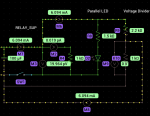dillond666
New Member
Hi,
I am aware that there is a maximum input impedance that should not be exceeded when doing ADC (2.5k?) But wish to measure the voltage of a 12v battery using ADC10.
Could I use higher resistances in my voltage divider if I put a capacitor across the resistor that the Picaxe is measuring the voltage across? Would this capacitor lower the
impedance at the Picaxe input?
Any advice gratefully received.
Derek
I am aware that there is a maximum input impedance that should not be exceeded when doing ADC (2.5k?) But wish to measure the voltage of a 12v battery using ADC10.
Could I use higher resistances in my voltage divider if I put a capacitor across the resistor that the Picaxe is measuring the voltage across? Would this capacitor lower the
impedance at the Picaxe input?
Any advice gratefully received.
Derek

